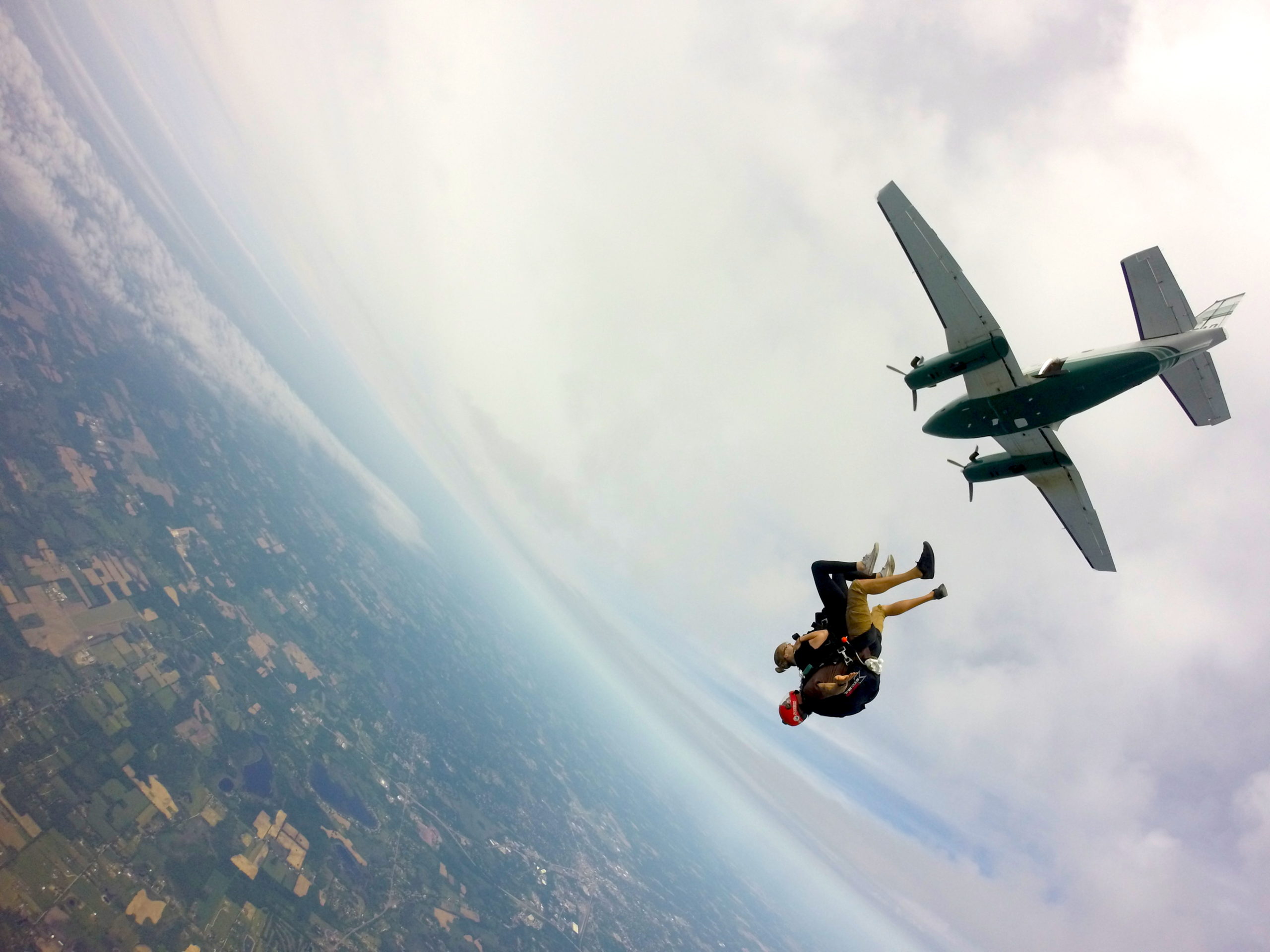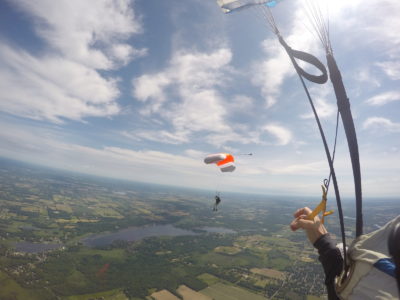Skydiving Heights & Altitudes Explained
Not all skydives are created equal. Beyond the spiffy amenities, awesome aircraft, amazing customer service, and professional staff – one of the main differences between skydives starts at skydiving heights and altitudes. And at Skydive Tecumseh, we kind of have it all! *star eyes*
So, how high is skydiving and why does it matter? Gather ’round, adventure lovers, we’ll explain.
Average Skydiving Height
How high do you go when skydiving? The majority of skydives happen anywhere between 8,000 to 14,000 feet with the average altitude for skydiving being around 10,000 feet. The reason for this is because of one of the most popular skydiving aircrafts, the Cessna 182. While this plane is popular due to its efficiency and workhorse capabilities, it is usually only capable of reaching up to 10,000 feet in altitude.

What Determines Skydiving Altitude?
Skydiving altitude is determined by the dropzone you’re jumping at, the skydiving aircraft you’re jumping out of, the type of jump you’re doing, and the minimum deployment altitude. As we mentioned above, most Cessna dropzones can only achieve a maximum altitude of 10,000 feet. But for dropzones that can own or lease turbine aircraft, they can take skydivers up to 14,000 feet and sometimes even above that in certain cases.
Can you skydive from 14,000 feet as a tandem skydiver? Yes, you can! Thanks to our two turbine aircrafts; a Beechcraft King Air and a PAC 750XL here at Skydive Tecumseh, we can take our guests up to 18,000 feet!
Other things that determine skydiving altitude are the type of skydiver you are and the type of jump you are doing. For tandem skydives, the dropzone predetermines the altitude options for its tandem students – this is set based on operations, aircraft capabilities, and price-point.
For licensed jumpers, the dropzone will normally give you a choice between a full altitude or low altitude jump. Other types of jumps outside of these two options are normally set up for special events, record-setting, or other special circumstances. Let’s talk about the difference between a low and high-altitude jump!
Low Altitude Jumps
Low-altitude jumps, also called hop-n-pops, are jumps that are usually made between 3,500 to 5,500 feet. The purpose of low-altitude jumps is to focus on the parachute ride portion of skydiving – whether you want to improve your canopy piloting skills or simply enjoy flying your canopy.
When we take a look at the United States Parachute Association (USPA) Skydiver’s Information Manual (SIM), there are minimum container opening altitudes and they are determined by the type of skydive, skydiver experience, and skydiving license certification. These are the lowest altitudes you can reach before pulling your parachute. Here are the minimum opening altitudes according to the USPA:
- Tandem Jumps: 5,000 feet AGL (Above Ground Level)
- All Students and A License Holders: 3,000 feet AGL
- B License Holders: 2,500 feet AGL
- C & D license Holders: 2,500 feet AGL (waiverable to ≥ 2,000 feet AGL)
High Altitude Jumps
According to the USPA, any jump over 15,000 feet AGL is considered a “high altitude jump” – or HALO (High Altitude Low Opening) jump – and will require supplemental oxygen to prevent potential hypoxia. Jumping from a higher altitude means more freefall time – which means more adventure for first-timers and more time to build big-way formations for licensed jumpers. Woohoo!
 How long does it take to skydive from 15,000 feet? About 60 to 70 seconds of freefall with a 5 to 7-minute parachute ride back down to the ground. However, this isn’t the highest you can jump from, a skydiver can jump from 30,000 feet and beyond! While it is rarely offered at skydiving centers, 30,000 feet is currently the highest verified altitude that you can skydive from in the United States and requires additional requirements/approvals from the FAA.
How long does it take to skydive from 15,000 feet? About 60 to 70 seconds of freefall with a 5 to 7-minute parachute ride back down to the ground. However, this isn’t the highest you can jump from, a skydiver can jump from 30,000 feet and beyond! While it is rarely offered at skydiving centers, 30,000 feet is currently the highest verified altitude that you can skydive from in the United States and requires additional requirements/approvals from the FAA.
Skydiving Height Facts
Here are more interesting facts about the height of parachute jumps!
Altitude Awareness
How do skydivers know when it’s time to pull the parachute? Skydivers rely on altimeters to gauge their height above ground level during a jump. These instruments use barometric pressures in the air to determine which altitude they’re at and can come analog or digital, and even in the audible form!
The Dangers of Hypoxia
At higher altitudes, the air becomes thinner, increasing the risk of hypoxia, a condition caused by oxygen deprivation. Symptoms include shortness of breath, confusion, changes in heart rate, and bluish skin. Hypoxia can be life-threatening so it is important to take the necessary precautions when jumping from higher altitudes.
Highest Skydive Ever
The current world record for the highest skydive is held by Google Executive, Alan Eustace, at an impressive 135,889 feet!
Military Operations
The military will use HALO and HAHO (high altitude, high opening) jumps from 30,000 to 40,000 feet as a way to gain entry into hostile regions for military operations.
Higher Skydives, Cooler Temps
Temperature changes about 10°F every 3,000 feet you increase in altitude. So, if it’s an 80°F day on the ground, expect temps to be around 33°F up at 14,000 feet. Brr!!
How High Do You Skydive From at Skydive Tecumseh?
At Skydive Tecumseh, we believe that you should be able to take your first time skydiving to the next level – which is why we offer tandem jumps from 9,000, 14,000, and 18,000 feet! Here are the freefall times for each to give you a bit of perspective:
- 9,000 feet: 30-second freefall
- 14,000 feet: 60-second freefall
- 18,000 feet: 90-second freefall
A skydive from any height is an unforgettable, life-changing experience that will have you walking on air! Book your skydive with the best in the Midwest, Skydive Tecumseh! Blue skies.
The post Skydiving Heights & Altitudes Explained appeared first on Skydive Tecumseh.

